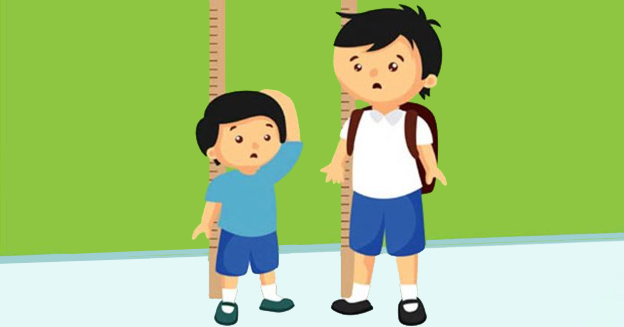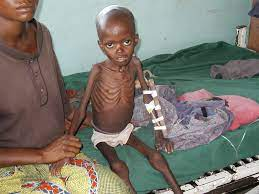Malnutrition, Overweight, Vitamins, Minerals, Proteins, Obesity, Nourishment.
Root Cause of Disease
Malnutrition is an imbalance in dietary intake. It occurs when a person has too much or too little food or essential nutrients. A person with malnutrition may lack vitamins, minerals, and other essential substances that their body needs to function.
People may become malnourished if they do not eat enough food overall. However, people who eat plenty but do not have enough variation in their diet can also become malnourished.
Malnutrition can mean undernutrition or overnutrition. It can also mean an imbalance of macronutrients (proteins, carbohydrates, fats) or micronutrients (vitamins and minerals).
Symptoms
Undernutrition may look like this:
- Low body weight, prominent bones, depleted fat, and muscle
- Thin arms and legs with edema (swelling with fluid) in your belly and face
- Stunted growth and intellectual development in children
- Weakness, faintness, and fatigue
- Irritability, apathy, or inattention
- Dry, inelastic skin, rashes, and lesions
- Brittle hair, hair loss, and hair pigment loss
- Frequent and severe infections
- Low body temperature, unable to get warm
- Low heart rate and blood pressure
Over-nutrition might look like this:
- Obesity
- High blood pressure
- Insulin resistance
- Heart disease
Causes
Undernutrition is usually caused by not eating enough nutrients. It can also be caused by certain medical conditions that prevent your body from absorbing nutrients.
You might have trouble getting enough nutrients if you have:
- Limited financial resources.
- Limited access to nutritious foods.
- Medical conditions that make eating difficult, such as nausea or difficulty swallowing.
- Medical conditions that deplete calories, such as chronic diarrhea or cancer.
- An extra need for calories, such as during pregnancy, breastfeeding, or childhood.
- Mental health conditions that discourage eating, such as depression or dementia.
- Eating disorders such as anorexia and bulimia.
- Malabsorption disorders such as pancreatic insufficiency or inflammatory bowel disease.
- A condition that requires long-term intravenous feeding.
- A very restricted diet or an unappealing diet is chosen by someone else.
Over-nutrition is caused by consuming more nutrients than you need. You might do this if you have:
- Few nutritious food options
- A sedentary lifestyle
- A condition that slows down your metabolism, such as hypothyroidism
- A hormone imbalance that interferes with your hunger and fullness signals
- Chronic stress
- Anxiety or depression
- Binge eating disorder
- Chronic overuse of dietary supplements
Home Remedies to treat Malnutrition
Remedy- 1: Treatment of malnutrition (Under-nutrition)
- Protein in each meal such as meat, fish, chicken, eggs, beans, or lentils
- High-calorie ingredients in meals and drinks include full cream milk, cheese, butter, olive oil, and cream.
- 3 small meals a day with 2-3 snacks in-between meals.


Procedure:
- Choose nourishing drinks such as milky drinks (malted drinks, hot chocolate, milky coffee, and milkshakes) or high-sugar drinks such as fruit juice, smoothies, fizzy drinks, or squash.
- Try including 1 pint of full cream milk each day – this can be enriched by adding 4 tablespoons of dried milk powder. Use this instead of milk and water in drinks, cooking, cereals, and puddings.
- Try not to have drinks just before meals to prevent you from feeling full.
- Add high-calorie ingredients to meals and drinks including full cream milk, cheese, butter, olive oil, and cream
Remedy- 2: Treatment of malnutrition(over-nutrition)


Procedure:
- Avoid foods that are high in carbohydrates like pasta, bread, or any kind of frozen food
- Drink an adequate amount of water throughout the day to maintain an ideal weight
- Eat lean meats and fish which are good sources of protein
- Include fruits and nuts in your diet
- Avoid foods that are high in sugar and salt
- Be active and exercise daily to maintain a healthy weight
- Have smaller meals at regular intervals
- Practice yoga or exercise every day
Remedy- 3: Avoiding malnutrition


Procedure:
- Ongoing screening and monitoring
- Making a dietary plan, which might include taking supplements
- Treating specific symptoms, such as nausea
- Treating any infections that may be present
- Checking for any mouth or swallowing problems
- Suggesting alternative eating utensils
In severe cases, a doctor may administer nutrients intravenously
Preventions
To prevent malnutrition, people need to consume a range of nutrients from various food types.
Children and elderly people who may not be able to advocate for themselves are especially at risk and may need closer attention paid to their diet and health condition.

The best way to prevent malnutrition is to eat a well-balanced diet with a variety of nutritious whole foods in it. If you have enough of all the nutrients your body needs, you will be less likely to overeat trying to satisfy those needs.
Some micronutrient deficiencies are common even with a fairly standard diet. A blood test is one way to find out if you could benefit from micronutrient supplements. Your healthcare provider can help you determine the correct dose to take.
Effects of Malnutrition in Children
Malnutrition can have long-lasting and devastating effects on children if the condition is not diagnosed and treated in time. Following are the consequences of malnutrition in childhood:
- Stunting: Stunting is one of the long-lasting effects of malnutrition in kids. Malnutrition can restrict a child’s ability to grow normally, restricting the height and weight of the child. Stunted growth can be permanent and irreversible.

- Marasmus: It is a severe protein-energy deficiency that can lead to malnutrition. Marasmus is also known for energy deficiency and is characterized by severe weight loss, thin and papery skin, hair loss, and periods of apathy and fatigue.

- Kwashiorkor: Kwashiorkor is also a result of severe protein-energy deficiency. Rashes, water retention, brittle hair, and a bloated belly are some of the symptoms of this condition. If not treated, this condition can lead to coma and death.





